#thinkWINTER. It starts with the Planning!
There’s no doubt about it that the key to post hill day happiness, sat in front of a fire with a steaming cup of hot chocolate, starts earlier in the week with planning. Winter walking and winter mountain days can bring you so much, but we know they can be a fickle friend.
We asked one of our Instructors for some top tips, things to think about and a brief look at some of the equipment you’ll need to take out with you. Weave these into your planning for happy type one fun:
Planning
This is fun. It is your excuse to pour over avalanche forecasts, maps (who doesn’t love a map), walking guide books, weather forecasts and general logistics planning. Know your team and their skillset – weaknesses, strengths and shared experiences. Teamwork in the mountains is really important. If you all enjoy the day, you’ll have a guaranteed hill buddy for your next hill adventure. Your group should influence your choices. Familiarise yourself with your preferred location and route. How long should it take, what sort of terrain is it – are you on established tracks (that might disappear under snow) tramping across heather, or does it involve a bit of scrambling. What height gain is involved and have an idea how many hours of ascent will this then take you and your friends. Does your chosen route match you and your teams skillset and experience?
.
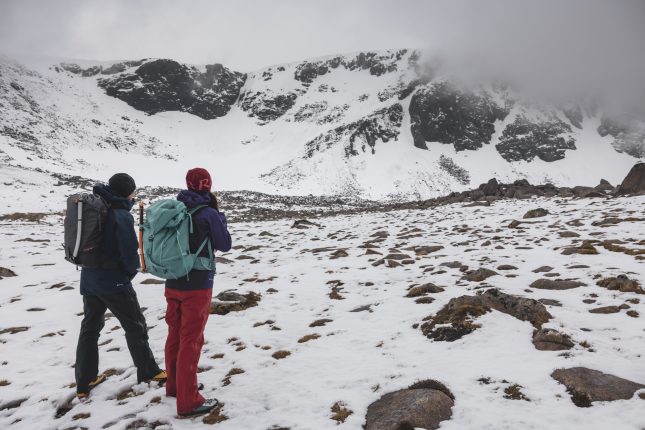
Photo credit: Ed Smith Photography
.
Weather and Conditions
Monitor conditions in the week leading up to your adventure. In the winter weather patterns can have a big impact on how much you enjoy your chosen adventure. How has wind deposited snow? Read the Scottish Avalanche Information Service reports and blog (sais.gov.uk). Read other blogs as well, but be selective – how many blog posts do you read that rave about how amazing the conditions/day was – but was it really? All of this will help you plan and visualise the mountain conditions that you could be faced with. Mountain Weather information Service will soon feature amongst your favourites list. The Metoffice also offers specific mountain weather reports as well.
.
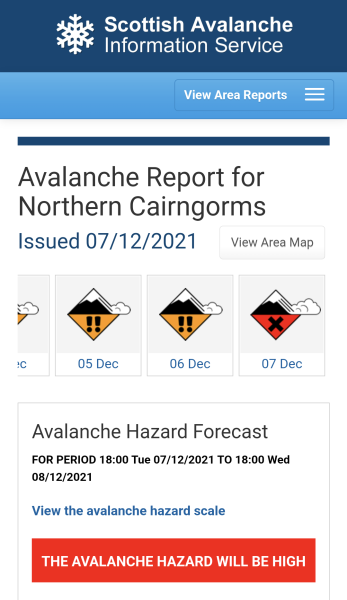
.
Equipment and kit
We will fill a whole article on kit alone – and we will! But in summary, carry good quality, winter equipment and know how to use it, for example ice axe and crampons. Boots need to be suitable for winter (stiffer than your normal summer weight walking boots and able to cope with snow all day). Clothing needs to be able to cope with cold and wet environments. Take multiple spare gloves – Wet hands are miserable if they get cold! Waterproof tops and bottom, not summer weight, but winter weight. Layer up with warm mid layers. Speak to a knowledgeable retailer who trains their staff, such as Ellis Brigham Mountain Sports.
Eye protection – work out whether you need sun glasses or clear goggles, or maybe both! If the forecast is a windy one, with snow, goggles are essential. And sun glasses will protect your eyes from the glare of the sun reflecting off a blue sky, winter wonderland – it does happen!
Poles – We love poles. They are a great tool when faced with deep snow conditions and for everyday mountain use will provide you with extra stability and are a bit kinder on your knees.
Navigation
Winterise your navigation. It is more challenging and harder than summer navigation so try to ensure that you are up to speed and well practiced and have learnt the skills required. Consider carrying digital navigation tools for back up, or maybe a GPS. Crucially you need to be able to navigate with and without GPS, so practice navigation in all its forms – map, phone, and GPS, before heading out. Remember to keep your phone and compass separate – phones can affect the compass and may cause something called reverse polarity. Of course, waterproof cases for the phone will avoid expensive issues!
.
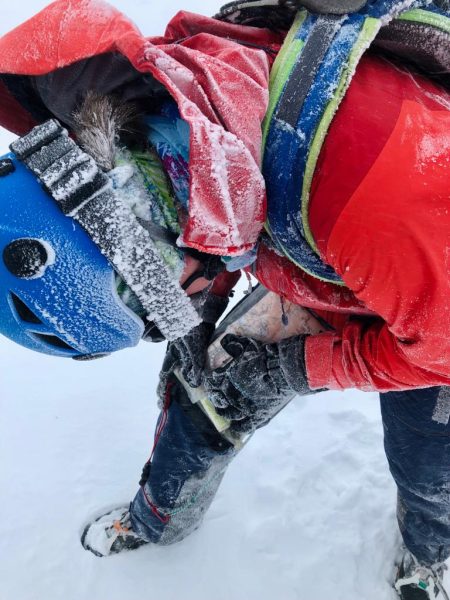
Photo credit: Stuart McAleese
.
Shorter Days
Days are shorter in the winter – particularly earlier on in the winter and you’ll need to factor in earlier starts, as well as carrying a fully charged head torch. Consider the length of day and the length of route choice. Refer to walking guidebooks for planning advice. If planning from a map, 300m of ascent per hour is quite a safe planning tip. Consider leaving a route plan – with a friend or accommodation provider.
Be aware of winter hazards
It sounds obvious, but winter means cold operating temperatures, snowfall and a new world of things to factor in. Icy footpaths. Avalanche risks. Cornices at the top of your hill. The potential for white out and blizzards. Don’t be daunted and don’t be put off, just learn how to manage these. A summer slope which feels steep can quickly feel perilous under snow/ice.
Also be prepared for a full day out. Winter conditions can be slow going and energy sapping, so the fitness of every person in your team is important. Does every member of your party have the fitness needed to cope? Don’t underestimate how tiring a winter hill walk can be. Ensure you are in good condition and strong, meaning you’ll enjoy the day a whole lot more. Fitness, strength and experience is often under estimated when it comes to hill walking. Especially in deep snow or if conditions deteriorate.
Enjoy yourself!
Winter does truly provide us with a wonderland. Snow and ice formations, winter light, it is a beautiful time of the year. In the Cairngorms National Park you could encounter Stags, Reindeer herds, snow buntings, winter hares, ptarmigan. If you are keen to head out but don’t know anyone to share the experience with then clubs, walking groups and training centres like Glenmore lodge provide you with the opportunity to not only gain skills and learn from others, but to meet like minded people to share these experiences with.
It will still be there tomorrow
Don’t be afraid to turn around if you don’t like what you encounter or the weather appears different to forecasts. There’s always tomorrow. Likewise don’t feel the pressure to stick to one specific route if conditions turn out to be less than favourable. Have a range of options in the location to meet the realities of the day.
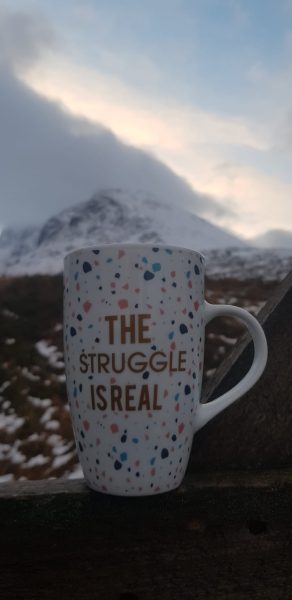
Photo: Ross Creber
Glenmore Lodge is sportscotland’s National Outdoor Training Centre. We run a range of winter skills courses, from introductory winter skills, through to winter climbing courses.
Trusted information sources for winter mountaineering include:
General mountaineering information:
www.mountaineering.scot/activities/thinkwinter – our guide to planning, decision making, equipment, winter skills and more.
Skills courses and training:
Mountaineering Scotland: www.mountaineering.scot/safety-and-skills/courses-and-events/courses
Glenmore Lodge: www.glenmorelodge.org.uk/winter-mountain/
Mountain Training’s winter qualifications: Winter Mountain Leader, Winter Mountaineering and Climbing Instructor. More info: www.mountain-training.org
Avalanche and weather information:
Scottish Avalanche Information Service: www.sais.gov.uk/
Mountain Weather Information Service: www.mwis.org.uk/
Met Office mountain forecasts: www.metoffice.gov.uk/weather/specialist-forecasts/mountain
Information about Mountain Rescue:
www.scottishmountainrescue.org/
For advice on calling for assistance from Mountain Rescue, see: https://www.mountaineering.scot/safety-and-skills/essential-skills/mountain-rescue/calling-for-help
Information about Mountain Biking:https://dmbins.com/campaigns/thinkwinter/
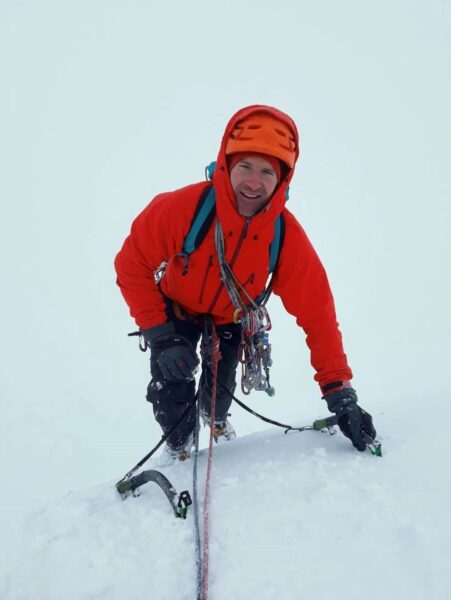
.
About Stuart McAleese
.
Originally from Northern Cumbria I started out hill walking in the Lake District when I was at school. I soon become interested in rock climbing and mountaineering, and was lucky enough to work and climb with Mountain Guides during my first job leaving school. Since then I’ve been working full time in the mountains for around 20 years.
At the same time as working, I enjoy climbing in my free time and have been lucky enough to go on many expeditions around the world, climbing new mountains, first ascents and tough remote summits. Places such as Patagonia, Alaska, Himalaya, Peru, Baffin Island, Yosemite and China. In 2004 I was nominated for the prestigious Piolet d’Or in Grenoble, France, for a 1st ascent of the ‘Supa Dupa Couloir’ in Alaska.
I love my job as a Mountain Guide, teaching and exploring big mountains in all weather all year round. I joined the Glenmore Lodge team in 2019 and head up the Summer Alpine programme as well as delivering on the Rock & Mountain programme of training courses.